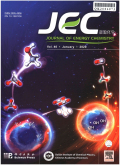- 钛学术文献服务平台 \
- 学术期刊 \
- 工业技术期刊 \
- 石油与天然气工业期刊 \
- 能源化学期刊 \
Coupling Co3[Co(CN)6]2 nanocubes with reduced graphene oxide for high-rate and long-cycle-life potassium storage
Coupling Co3[Co(CN)6]2 nanocubes with reduced graphene oxide for high-rate and long-cycle-life potassium storage
基本信息来源于合作网站,原文需代理用户跳转至来源网站获取
摘要:
As one of prussian blue analogues,Co3[Co(CN)6]2 has been explored as a promising anode material for potassium-ion batteries (PIBs) owing to its high potassium storage capacity.Unfortunately,Co3[Co(CN)6]2 possesses low electronic conductivity and its structure collapses easily during potassiation and depotassiation,resulting in poor rate performance and cyclic stability.To solve these problems,we develop a facile multi-step method to successfully combine uniform Co3[Co(CN)6]2 nanocubes with rGO by C-O-Co bonds.As expected,these chemcial bonds shorten the distance between Co3[Co(CN)6]2 and rGO to the angstrom meter level,which significantly improve the electronic conductivity of Co3[Co(CN)6]2.Besides,the complete encapsulation of Co3[Co(CN)6]2 nanocubes by rGO endows the structure of Co3[Co(CN)6]2 with high stability,thus withstanding repeated insertion/extraction of potassium-ions without visible morphological and structural changes.Benefiting from the abovementioned structural advantages,the Co3[Co(CN)6]2/rGO nanocomposite exhibits a high reversible capacity of 400.8 mAh g-1 at a current density of 0.1 A g-1,an exceptional rate capability of 115.5 mAh g-1 at 5 A g-1,and an ultralong cycle life of 231.9 mAh g-1 at 0.1 A g-1 after 1000 cycles.Additionally,the effects of different amounts of rGO and different sizes of Co3[Co(CN)6]2 nanocubes on the potassium storage performance are also studied.This work offers an ideal route to significantly enhance the electrochemical properties of prussian blue analogues.

推荐文章
Mn3[Co(CN)6]2@SiO2对鼠C6脑胶质瘤模型3T MR成像及生长规律的研究
纳米粒子
分子影像
C6胶质瘤
MR成像
生长规律
水热法微/纳米 Gd2(CO3)3· H2O 和G d2O 3的合成与表征
水热法
Gd2(CO3)3·H2O
Gd2O3
荧光性
混合熔融Li2CO3-Na2CO3-K2CO3体系表面张力计算
熔融碳酸盐
表面张力
模型
Butler方程
NO与Co(NH3)2+6气液反应动力学
动力学
吸收
气液反应
一氧化氮
内容分析
关键词云
关键词热度
相关文献总数
(/次)
(/年)
引文网络
引文网络
二级参考文献 (0)
共引文献 (0)
参考文献 (0)
节点文献
引证文献 (0)
同被引文献 (0)
二级引证文献 (0)
2021(0)
- 参考文献(0)
- 二级参考文献(0)
- 引证文献(0)
- 二级引证文献(0)
引文网络交叉学科
相关学者/机构
期刊影响力
能源化学
主办单位:
中国科学院大连化学物理研究所
中国科学院成都有机化学研究所
出版周期:
双月刊
ISSN:
2095-4956
CN:
10-1287/O6
开本:
出版地:
大连市中山路457号
邮发代号:
创刊时间:
语种:
eng
出版文献量(篇)
2804
总下载数(次)
0
总被引数(次)
7996
期刊文献
相关文献
推荐文献
- 期刊分类
- 期刊(年)
- 期刊(期)
- 期刊推荐
一般工业技术
交通运输
军事科技
冶金工业
动力工程
化学工业
原子能技术
大学学报
建筑科学
无线电电子学与电信技术
机械与仪表工业
水利工程
环境科学与安全科学
电工技术
石油与天然气工业
矿业工程
自动化技术与计算机技术
航空航天
轻工业与手工业
金属学与金属工艺
能源化学2022
能源化学2021
能源化学2020
能源化学2019
能源化学2018
能源化学2017
能源化学2016
能源化学2015
能源化学2014
能源化学2013
能源化学2012
能源化学2011
能源化学2010
能源化学2009
能源化学2008
能源化学2007
能源化学2006
能源化学2005
能源化学2004
能源化学2003
能源化学2002
能源化学2001
能源化学2021年第9期
能源化学2021年第8期
能源化学2021年第7期
能源化学2021年第6期
能源化学2021年第5期
能源化学2021年第4期
能源化学2021年第3期
能源化学2021年第2期
能源化学2021年第12期
能源化学2021年第1期

 免费查重
免费查重










